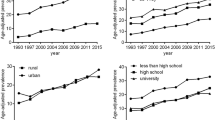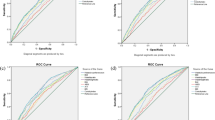Abstract
Objectives:
To determine the prevalence of generalized and abdominal obesity in urban Asian Indians and compare the association of body mass index (BMI) and waist circumference (WC) with metabolic risk variables.
Methods:
Subjects were recruited from the Chennai Urban Rural Epidemiology Study (CURES) carried out between 2001 and 2004 and involved 2350/2600 eligible subjects (response rate 90.4%). Anthropometric measurements, lipids and oral glucose tolerance tests were carried out. Generalized obesity (BMI⩾23 kg m−2) and abdominal obesity (WC⩾90 cm in men and ⩾80 cm in women) were defined using WHO Asia Pacific guidelines.
Results:
The age standardized prevalence of generalized obesity was 45.9% (95% CI: 43.9–47.9%), (women: 47.4%; men: 43.2%, P=0.210), while that of abdominal obesity was 46.6% (95% CI: 44.6–48.6%), (women: 56.2%> men: 35.1%, P<0.001). Area under the curve for identifying subjects with any three metabolic risk factors using BMI was 0.66, 95% CI: 0.63–0.69, P<0.001, while, for WC, it was 0.70, 95% CI: 0.66–0.74, P<0.001 for men, and 0.69, 95% CI: 0.65–0.74, P<0.001 for women. Isolated generalized obesity (normal WC, increased BMI) was present in 12.7% of men and 6.1% of women. Isolated abdominal obesity (increased WC, normal BMI) was present in 4.7% of men and 14% of women. Combined obesity was present in 32.6% of men and 43.3% of women.
Conclusions:
In Asian Indians, the prevalence of combined obesity is high among both sexes, while isolated generalized obesity is more common in men and isolated abdominal obesity more common in women. However, these prevalence rates vary markedly depending on cut points used. WC is a better marker of obesity-related metabolic risk than BMI in women compared to men in this population.
This is a preview of subscription content, access via your institution
Access options
Subscribe to this journal
Receive 12 print issues and online access
$259.00 per year
only $21.58 per issue
Buy this article
- Purchase on Springer Link
- Instant access to full article PDF
Prices may be subject to local taxes which are calculated during checkout



Similar content being viewed by others
References
Alberti KG, Zimmet PZ (1998). Definition diagnosis and classification of diabetes mellitus and its complications. Part 1: diagnosis and classification of diabetes mellitus, provisional report of a WHO consultation. Diabet Med 15, 539–553.
Chuprapavarn J (1996). First report on survey of health status in Thai populations by questionnaires and physical examination, 1991–1992. Institute of Public Health: Bangkok.
Dagenais GR, Yi Q, Mann JFE, Bosch J, Pogue J, Yusuf S (2005). On behalf of the Heart Outcomes Prevention Evaluation (HOPE) study investigators. Prognostic impact of body weight and abdominal obesity in women and men with cardiovascular disease. Am Heart J 149, 54–60.
de Koning L, Merchant AT, Pogue J, Anand S (2007). Waist circumference and waist-to-hip ratio as predictors of cardiovascular events: meta-regression analysis of prospective studies. Eur Heart J 28, 850–856.
Deepa M, Pradeepa R, Rema M, Anjana M, Deepa R, Shanthirani S et al. (2003). The Chennai Urban Rural Epidemiology Study (CURES)—study design and methodology (Urban Component) (CURES—1). J Assoc Physicians India 51, 863–870.
Deurenberg-Yap M, Chew SK, Deurenberg P (2002). Elevated body fat percentage and cardiovascular risks at low body mass index levels among Singaporean Chinese, Malays and Indians. Obes Rev 3, 209–215.
Deurenberg-Yap M, Chew SK, Lin VF, Tan BY, van Staveren WA, Deurenberg P (2001). Relationships between indices of obesity and its co-morbidities in multi-ethnic Singapore. Int J Obes Relat Metab Disord 25, 1554–1562.
Ge L (1997). Body mass index in young Chinese adults. Asia Pac J Clin Nutr 6, 175–179.
Grundy SM (2005). Metabolic Syndrome Scientific Statement by the American Heart Association and the National Heart, Lung, and Blood Institute. Arterioscler Thromb Vasc Biol 25, 2243–2244.
International Diabetes Federation (2005). New IDF worldwide definition of the metabolic syndrome. Press Conference, 1st International Congress on ‘Pre-diabetes’ and the Metabolic Syndrome, Berlin, Germany, 14 April,(http://www.idf.org/).
Ismail MN, Zawiah H, Chee SS, Ng KK (1995). Prevalence of obesity and chronic energy deficiency (CED) in adult Malaysians. Malays J Nutr 1, 1–9.
Ito H, Nakasuga K, Ohshima A, Maruyama T, Kaji Y, Harada M et al. (2003). Detection of cardiovascular risk factors by indices of obesity obtained from anthropometry and dual-energy X-ray absorptiometry in Japanese individuals. Int J Obes Relat Metab Disord 27, 232–237.
Ko GT, Chan JC, Woo J, Lau E, Yeung VT, Chow CC et al. (1997). Simple anthropometric indexes and cardiovascular risk factors in Chinese. Int J Obes 21, 995–1001.
Kumar BN, Meyer HE, Wandel M, Dalen I, Holmboe-Ottesen G (2006). Ethnic differences in obesity among immigrants from developing countries, in Oslo, Norway. Int J Obes 30, 684–690.
Lin WY, Lee LT, Chen CY, Lo H, Hsia HH, Liu IL et al. (2002). Optimal cut-off values for obesity: using simple anthropometric indices to predict cardiovascular risk factors in Taiwan. Int J Obes Relat Metab Disord 26, 1232–1238.
Mamtani MR, Kulkarni HR (2005). Predictive performance of anthropometric indexes of central obesity for the risk of type 2 diabetes. Arch Med Res 36, 581–589.
Mohan V, Deepa R, Deepa M, Somannavar S, Datta M (2005). A simplified Indian Diabetes Risk Score for screening for undiagnosed diabetic subjects. J Assoc Physicians India 53, 759–763.
Mohan V, Sandeep S, Deepa M, Gokulakrishnan K, Datta M, Deepa R (2006). A diabetes risk score helps identify metabolic syndrome and cardiovascular risk in Indians—the Chennai Urban Rural Epidemiology Study (CURES—38). Diabetes Obes Metab 9, 337–343.
Moon OR, Kim NS, Jang SM, Yoon TH, Kim SO (2002). The relationship between body mass index and the prevalence of obesity-related diseases based on 1995 National Health Interview Survey in Korea. Obes Rev 3, 191–196.
Nakagami T, Qiao Q, Carstensen B, Nhr-Hansen C, Hu G, Tuomilehto J et al. (2003). The DECODE-DECODA Study Group. Age, body mass index and type 2 diabetes-associations modified by ethnicity. Diabetologia 46, 1063–1070.
National cholesterol education program (NCEP) (2001). Executive summary of the third report of the national cholesterol education program (NCEP) Expert Panel on Detection, Evaluation and Treatment of High Blood Cholesterol in Adults (Adult Treatment Panel III). JAMA 285, 2486–2497.
Okosun IS, Prewitt TE, Cooper RS (1999). Abdominal obesity in United States: prevalence and attributable risk of hypertension. J Hum Hypertens 13, 425.
Pua YH, Ong PH (2005). Anthropometric indices as screening tools for cardiovascular risk factors in Singaporean women. Asia Pac J Clin Nutr 14, 74–79.
Vikram NK, Pandey RM, Misra A, Sharma R, Rama Devi J, Khanna N (2003). ‘Non-obese’ (BMI<25 kg/m2) Asian Indians with ‘normal’ waist circumference have high cardiovascular risk. Nutrition 19, 503–509.
World Health Organization (WHO) (2000). The Asia Pacific Perspective. Redefining Obesity and Its Treatment. International Associaton for the Study of Obesity and International Obesity Task Force. International Diabetes Institute: Melbourne.
World Health Organization (WHO) Expert Consultation (2004). Appropriate body mass index for Asian populations and its implications for policy and intervention strategies. Lancet 363, 157–163.
Yajnik CS (2004). Symposium on ‘Adipose tissue development and the programming of adult obesity’. Obesity epidemic in India: intrauterine origins? Proc Nutr Soc 63, 387–396.
Yajnik CS (2006). Waist–hip ratio: a thrifty phenotype? Natl Med J India 19, 200–201.
Yusuf S, Hawken S, Ounpuu S, Bautista L, Franzosi MG, Commerford P et al. (2005). Obesity and the risk of myocardial infarction in 27 000 participants from 52 countries: a case–control study. Lancet 366, 1640–1649.
Acknowledgements
We are grateful to the Chennai Willingdon Corporate Foundation, Chennai for the financial support provided for the study. We thank the Epidemiology team members for conducting the CURES field studies. This is the 47th publication from CURES.
Author information
Authors and Affiliations
Corresponding author
Additional information
Contributors: VM designed the study. MD and SF conducted the study and wrote the first draft of the manuscript and VM rewrote the subsequent drafts. RD assisted in doing statistical analysis. VM, DM and RD contributed to the interpretation of the data and all contributors participated in the revisions and final draft of the manuscript.
Rights and permissions
About this article
Cite this article
Deepa, M., Farooq, S., Deepa, R. et al. Prevalence and significance of generalized and central body obesity in an urban Asian Indian population in Chennai, India (CURES: 47). Eur J Clin Nutr 63, 259–267 (2009). https://doi.org/10.1038/sj.ejcn.1602920
Received:
Revised:
Accepted:
Published:
Issue Date:
DOI: https://doi.org/10.1038/sj.ejcn.1602920
Keywords
This article is cited by
-
Magnitude of central obesity and associated factors among adult patients attending public health facilities in Adama town, Oromia region, Ethiopia, 2022
Journal of Health, Population and Nutrition (2023)
-
Association of anthropometric parameters as a risk factor for development of diabetic retinopathy in patients with diabetes mellitus
Eye (2023)
-
Obesity and dyslipidemia among Bhil tribal population: A cross-sectional study from India
International Journal of Diabetes in Developing Countries (2022)
-
Association of Indices of Adiposity with Lipoprotein Sub-fractions in the general Population of Amritsar City
Proceedings of the Indian National Science Academy (2022)
-
Relationship between leptin gene variants (–2548G>A and 19A>G) and obesity among north Indian Punjabi population
Journal of Genetics (2022)



